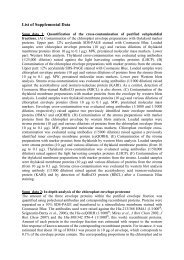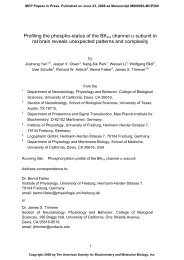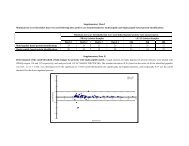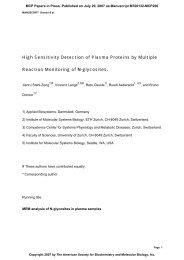Super-SILAC allows Classification of Diffuse Large B-cell ...
Super-SILAC allows Classification of Diffuse Large B-cell ...
Super-SILAC allows Classification of Diffuse Large B-cell ...
You also want an ePaper? Increase the reach of your titles
YUMPU automatically turns print PDFs into web optimized ePapers that Google loves.
Summary<br />
Correct classification <strong>of</strong> cancer patients into subtypes is a prerequisite for acute diagnosis and<br />
effective treatment. Currently this classification relies mainly on histological assessment but gene<br />
expression analysis by microarrays has shown great promise. Here we show that high accuracy,<br />
quantitative proteomics can robustly segregate cancer subtypes directly at the level <strong>of</strong> expressed<br />
proteins. We investigated two histologically indistinguishable subtypes <strong>of</strong> diffuse large B-<strong>cell</strong><br />
lymphoma (DLBCL), activated B-<strong>cell</strong>-like (ABC) and germinal-center B-<strong>cell</strong>-like (GCB) by first developing<br />
a general lymphoma super-<strong>SILAC</strong> mix from heavy stable isotope labeled <strong>cell</strong> lines. This super-<strong>SILAC</strong><br />
mix was combined with <strong>cell</strong> lysates from five ABC-DLBCL and five GCB-DLBCL <strong>cell</strong> lines. Shotgun<br />
proteomic analysis on a linear ion trap Orbitrap mass spectrometer with high mass accuracy at the MS<br />
and MS/MS levels yielded a identified proteome <strong>of</strong> more than 7,500 proteins. High accuracy <strong>of</strong><br />
quantification allowed robust separation <strong>of</strong> subtypes by principal component analysis. The main<br />
contributors to the classification included proteins known to be differentially expressed between the<br />
subtypes such as the transcription factors IRF4 and SPI1/PU.1, <strong>cell</strong> surface markers CD44 and CD27 as<br />
well as novel candidates. We extracted a signature <strong>of</strong> 55 proteins that segregated subtypes and<br />
contained proteins connected to functional differences between the ABC and GCB-DLBCL subtypes,<br />
including many NF-κB regulated genes. Shortening the analysis time to single-shot analysis combined<br />
with use <strong>of</strong> the new linear quadrupole Orbitrap analyzer (Q Exactive) also clearly differentiated<br />
between the subtypes. These results show that high resolution shotgun proteomics combined with<br />
super-<strong>SILAC</strong> based quantification is a promising new technology for tumor characterization and<br />
classification.<br />
[2]








